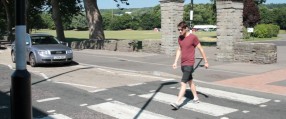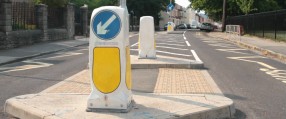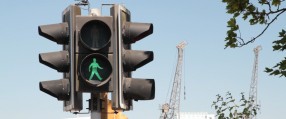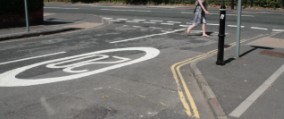Puffin Crossings
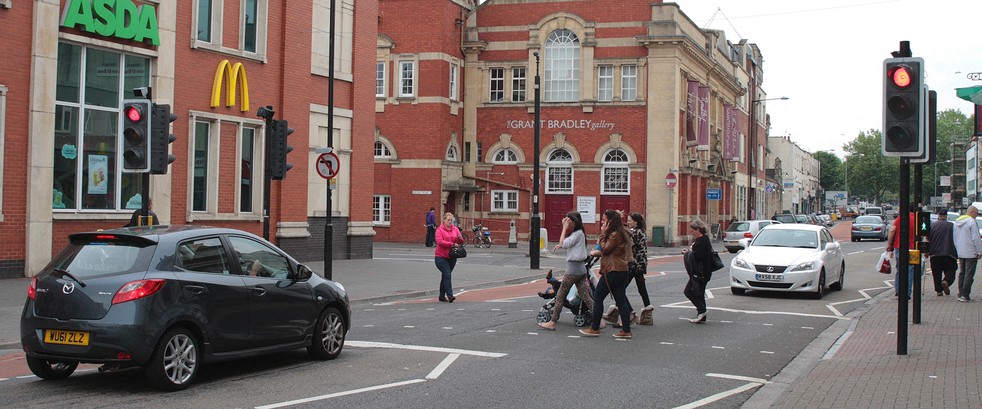
Puffin Crossings use traffic lights to stop vehicle traffic, allowing pedestrians to cross. Pedestrians push a button at the side of the road, and wait for a signal to cross - this is from a standing red man to a walking green man. A beeping sound is usually heard when the walking green man is shown.
Puffin crossings are a modern crossing design which have the pedestrian demand button and pedestrian signal (green/red man) in the same place, on a pole at the near side of the road. The kerbs are dropped at both ends of the crossing, usually with tactile paving where the pavement slopes towards the road.
Puffin crossings have sensors to detect if there are pedestrians waiting at the side of the road to cross. This allows the Puffin crossing to cancel the crossing demand, as it won't be needed if the pedestrians are no longer there. Another sensor is used to extend the crossing time if necessary, by checking/monitoring for pedestrians still in the crossing area.
Puffin crossings are similar to Pelican crossings, which are much older in design and no longer installed in Bristol. Pelican crossings have the pedestrian signal at the opposite side of the road; do not have any pedestrian sensors; and have a flashing light phase at the end of the crossing time. Read about Pelican crossings here.
Disadvantages
- Puffin crossings are the most expensive crossing type
- Pedestrians must wait for the signal before crossing. It may take considerably less time to cross at a Zebra crossing
- Pedestrians may walk into the road when the signal changes without checking vehicle traffic has come to a complete stop
- May be less attractive than other crossing types, which are less obtrusive in smaller streets with narrow pavements
- Other pedestrians may obscure the view of the pedestrian crossing light located on the nearside of the road
- Expensive to maintain
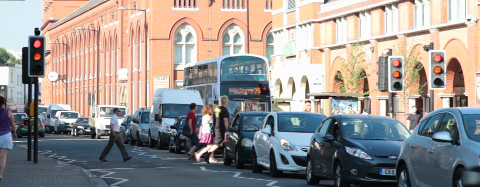
Restrictions
- Puffin crossings can't be installed within 20 meters of a junction or roundabout
- Traffic light signals must be visible to approaching vehicles
- The beeping sound heard at Puffin crossings may cause a noise problem for any nearby houses. However, the beeping noise can work to a timer, and only operate at certain hours of the day.
There's also some general restrictions to note for all schemes
Advantages
- Pedestrians given a clear signal when to cross
- Vehicle users given clear signal when to stop for pedestrians
- Crossing times are automatically extended for slower pedestrians (e.g. elderly or disabled people)
- Vehicle users should never have to stop when nobody is using the crossing
- Pedestrians never have to wait too long to cross
- Can help maintain vehicle traffic flow in busy pedestrian areas when a Zebra crossing would cause traffic delays
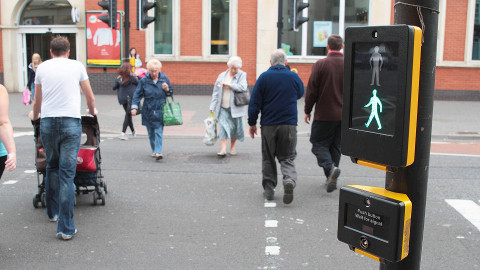
Effectiveness
Usability
Puffin crossings reduce the chance of pedestrians feeling uncomfortable while they are crossing, because a red light should always be shown to vehicle users when somebody is crossing, even if they are crossing slowly.
Safety
Compared to a traditional Pelican crossing, Puffin crossings reduce the amount of times a pedestrian is injured by 24%. For motor vehicle drivers who were injured, this is reduced by 16%.
Compared to Pelican crossings, Puffin crossings are safer to use because they do not have a phase where the amber light flashes to vehicle users, and green man flashes to pedestrians. This phase causes confusion to both vehicle users and pedestrians. Puffin crossings do not use this phase, and show either green or red crossing signals to pedestrians.
It's more difficult to compare Puffin crossings to Zebra crossings because there is less research. It is most likely that Puffin crossings are very similar to Zebra crossings in safety, or zebra crossings are only marginally less safe.
Toucan Crossing
Puffin crossings can become Toucan crossings by adding a bicycle symbol to the red/green crossing man, and increasing the crossing width. This means cyclists are allowed to ride across the crossing without having to dismount.
Advanced information
Research for TfL (Outlook Research, 2005) states perception of reduced harassment from motor vehicles is a key advantage for pedestrians using puffin crossings. This is due to the variable extension of crossing timings using the on crossings sensors.
Pedestrian confusion on the flashing green man phase is based on findings from Transport for London (2005, Outlook Research) This report found 35% of pedestrians surveyed at Pelican crossings did not know they should not start to cross the road upon seeing the green flashing man. This research is based on good quality evidence using face-to-face interviews at Puffin and Pelican crossings.
Puffin crossing safety compared to Pelican crossings is based on research from Maxwell et al. (2011). This research uses an excellent and rigorous study design. This research supersedes previous findings comparing Puffin and Pelican crossings from the Highways Agency (1997). Research from the London Road Safety Unit (2006) found greater safety benefits of Puffin crossings compared to Pelicans for pedestrians (-30% reduction in accidents), however this employed a weaker study design, with approximately half the study sites. Therefore, the more conservative figure from the stronger study from Maxwell et al. is given above.
Comparisons between Zebra crossings and Puffin crossings are based on a relatively weak study from the London Road Safety Unit (2006). This study examined only 6 sites, however the study design was strong within that constraint. Results were an 8% reduction in pedestrian accidents when Zebra crossings were converted to Puffin crossings, however this figure was not statistically significant because there were too few incidents in the study period.
References
Maxwell, A., Kennedy, J., Routledge, I., Knight, P., Wood, K. (2011) - Puffin pedestrian crossing accident study (PPR507). Transport Research Laboratory. Crowthorne, UK.
Outlook Research (2005) Puffin and Pelican Crossings: views of pedestrian users. Report for Transport for London.
Webster, N. (2006) The effect of newly installed Puffin crossings on collisions. London Road Safety Unit, London, UK.

